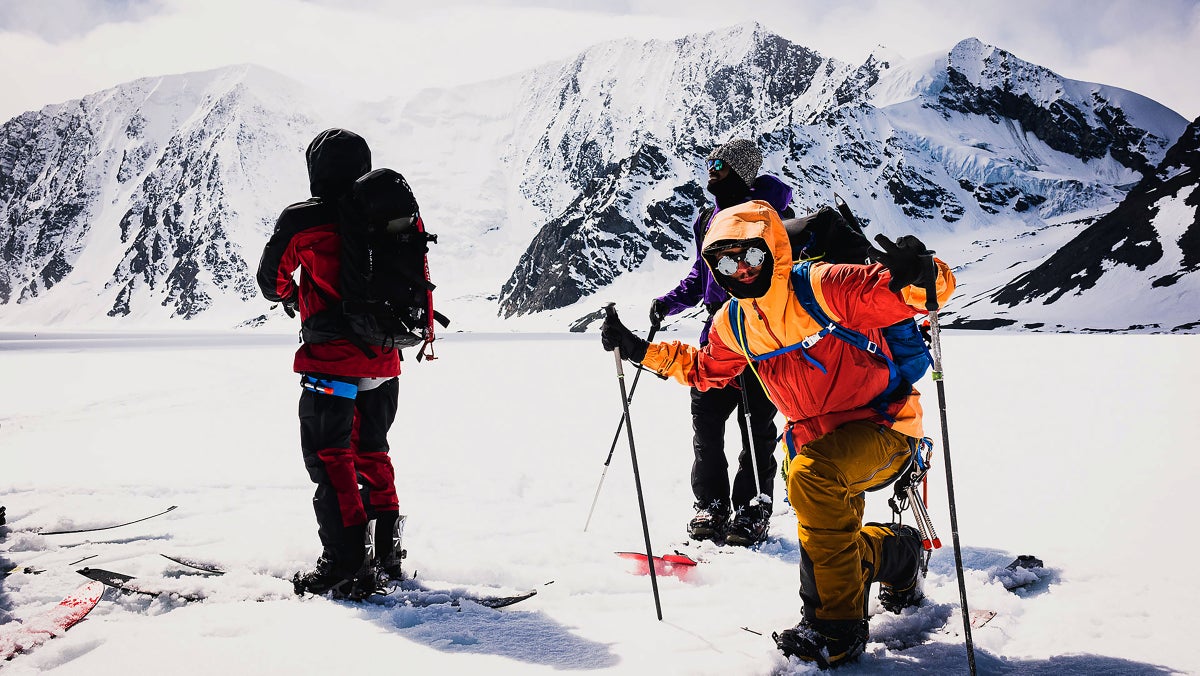
Ryan Hudson sits in a dug-out snow bench in Alaska’s Chugach Mountains. “People will always remind me of the color of my skin, no matter what,” he says as snow spits around him. “To everyone, I’m a Black snowboarder.” The scene, with Hudson between iconic big-mountain freerider Jeremy Jones and Hispanic snowboarder Rafael Pease, is key to Teton Gravity Research’s new film Mountain Revelations. There’s no place too remote for the specter of racism and inequality.
That includes skiing and snowboarding and the stoke films that have been mainstays of mountain culture for decades, but still tend to feature athletes who are white and male. Mountain Revelations and another new film coming out this fall, The Approach, aim to confront that legacy and bring new energy to the genre.
Unlike TGR’s famed large-cast action films, Mountain Revelations is more of a documentary format, following the trio of snowboarders on a ten-day trip in the Chugach. The goal: to look at racial privilege in the snow sports world and start conversations on film between athletes with markedly different backgrounds—and ride some sick lines, of course.
“We want to show people that, yes, I could stand next to Jeremy Jones on the snowboard and drop in the same line as him. We’re out here kicking ass.”
Executive producer Drew Holt was inspired by the racial justice movement in the summer of 2020, and “the stress and anger and frustration with what was happening from a race perspective,” he says. After seeing posts about racial inequities on Jeremy Jones’s social media feeds, he reached out to the longtime TGR athlete, and then thought of Salt Lake City snowboarder Hudson and the world-hopping Pease. “The best way to tell a story is to get people deep into the backcountry, where they can be really honest and reflective,” says the producer.
In its last annual participation report, Snowsports Industries America found that involvement in winter sports was overwhelmingly white (67.5 percent) and decreasing among Black participants (down to less than ten percent).
“I can’t say that I speak for the entire population of athletes of color, but I know that over time, it can get better,” says Hudson who’s become increasingly comfortable with talking about his background of being homeless as a teenager and discovering snowboarding through an outreach program. The film, as he describes it, was about three individuals “exercising their right to explore.”
For Pease, who splits his time between Chile and Montana, Mountain Revelations was his first chance to visit Alaska. The film, he says, felt like a small start. “If you really want to talk about it, you shouldn’t have a few men talking about what it’s like being racially different,” he says, and wishes a woman had been part of the cast as well. He says while some of the change he sees in the outdoor industry feels inauthentic, the film was a chance to show that a Hispanic athlete can perform on the sport’s highest stage.
While a solid start, of course Mountain Revelations is only one film. Holt points out that Sierra Nevada came on as a sponsor for the project, but he was surprised by the lack of involvement from many other brands. And there’s the fact that the flagship TGR film Stoke the Fire stars 17 white athletes (albeit with several women in their ranks).
“I think this film is a good indication of where we’re going, striving to be actually inclusive instead of tokenizing.”
Washington state filmmaker Anne Cleary went a different route with The Approach, another shred film debuting this fall. Kickstarted by her frustration at being the token female in so many spaces, legendary skier Ingrid Backstrom gathered a crew of athletes with varied backgrounds—Black skier Brooklyn Bell, Black snowboarder Emilé Zynobia, and Canadian snowboarder Spencer O’Brien, who is of Indigenous descent. When adaptive skier Vasu Sojitra came on board, he refused to be the sole disabled athlete; he recruited Bend sit skier Anna Soens to join the group.
When women appear in ski films made by men, says Cleary, “you get a lot of hair blowing in the wind moments.” The Approach instead captures broken down vans and Backstrom threatening to moon the camera. It wraps with a classic Alaskan heli-ski trip, the kind of big-mountain shots that have for so long featured mostly white men. “I think this film is a good indication of where we’re going, striving to be actually inclusive instead of tokenizing,” says Cleary.
Pease also believes that the action sequences will speak as loudly as the camp chats in Mountain Revelations. “We want to show people that, yes, I could stand next to Jeremy Jones on the snowboard and drop in the same line as him. We’re out here kicking ass.”
The post Stoke Films Are Very White. Two New Entries Are Trying to Change That. appeared first on Outside Online.
by awise via Outside Online
Comments